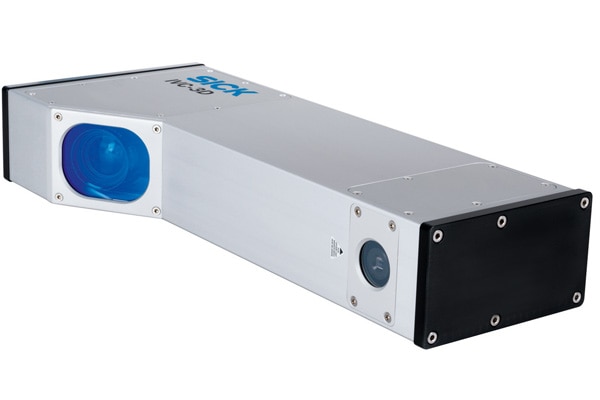Producers of building materials want to ensure that their products are of the highest quality possible, and in the production of special bricks for blast furnaces - which are particularly susceptible to surface damage - being able to carry out quality control during the production process is indispensable. A system has been developed in the Czech Republic, where bricks are scanned during transport on conveyor belts. As part of this scan, 3D vision sensors from SICK create 3D models of each individual brick. The 3D models can be used to determine the precise dimensions of the brick and the extent of its damage.
The system consists of an automated robot from ABB (a leading international company in energy and automation engineering), a control panel, a sensor for precise width measurement and four IVC-3D vision sensors from SICK. These sensors feature an optical resolution of 0.2 mm, and are capable of performing in the unfavorable industrial conditions. The 3D vision sensors operate according to the principle of triangulation distance measurement. The line laser beam which is integrated into the sensor housing projects a light track on objects, allowing their profile to be determined. The IVC-3D sensors are able to use these profiles to create precise 3D images of the magnesium bricks, measuring them with high precision and detecting volume errors. This allows the quality of the bricks to be checked during the production process, meaning defective objects can be quickly discarded. IVC-3D vision sensor from SICK.
IVC-3D vision sensor from SICK.
Connecting a network of communicating sensors
The IVC Studio software, which can be used to create bespoke measuring programs with more than 100 tools, was applied to program the IVC-3D vision sensors. The measuring program is saved in the flash memory of the IVC-3Ds, allowing them to continue to operate without being connected to a computer. In this system, the IVC-3Ds are mounted around specially designed conveyors, networked in a way that allows them to communicate with one another. In each system, one of the 3D vision sensors is designated as the control sensor, collecting information from subordinate sensors and transmitting the measurement results to the automated ABB IRB 6640 Foundry robot, which is responsible for the mechanical loading and unloading of bricks from the conveyor belts. At the same time, the 3D vision sensors communicate with the control panel. This control panel allows for the entry of the measurement parameters and, where necessary, data archiving for subsequent inspection. An OD Precision displacement measurement sensor from SICK, which boasts a measurement accuracy of 0.01 mm, additionally supports the whole system.
Simple operation with excellent process overview
Operation of the control system is simple: Initiating the robotic unit is as easy as pressing the START button. Transport carriages bring the bricks to the designated location, where they are unloaded on pallets. From here, the robot loads individual bricks onto the conveyor. After scanning, the 3D control sensor systematically assesses the properties of the bricks and transmits data on their quality to the robot. Finally, the bricks are stacked on one of four pallets. The control panel temporarily displays the measured values before permanently saving them, and a red warning light alerts the operator to any defective products. System parameters, such as individual tolerance thresholds, can be easily configured via the operating panel, allowing the system to be flexibly adjusted according to changing requirements. This wide range of adjustment possibilities means the system can ensure optimum quality for an enormous number of product types.
- Product information: IVC-3D, OD Precision
- Product portfolio: 3D vision, Displacement measurement sensors

